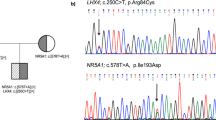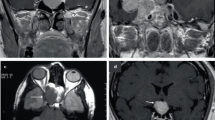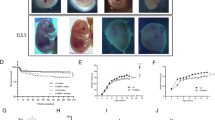Abstract
The genetic causes of combined pituitary hormone deficiency remain elusive in most patients. Recently, incompletely penetrant heterozygous mutations in ROBO1 have been described in patients with pituitary stalk interruption syndrome. Herein, we identified a novel homozygous slice site mutation in ROBO1 (c.1342+1G>A) using a trio whole-exome sequencing strategy in a 5-year-old Japanese boy who had combined pituitary hormone deficiency, psychomotor developmental delay, severe intellectual disability, sensorineural hearing loss, strabismus, and characteristic facial features, including a broad forehead, micrognathia, and arched eyebrows. Magnetic resonance imaging delineated anterior pituitary hypoplasia, ectopic posterior pituitary, invisible pituitary stalk, thinning of the corpus callosum, and hypoplasia of the pons and midbrain. The phenotypically normal parents (first cousins) were heterozygous for the mutation. The results provide further evidence of ROBO1 being involved in the development of the pituitary gland. A recessive mutation of ROBO1 is a potential novel cause of a syndromic disorder associated with combined pituitary hormone deficiency.
Similar content being viewed by others
Log in or create a free account to read this content
Gain free access to this article, as well as selected content from this journal and more on nature.com
or
References
Kelberman D, Rizzoti K, Lovell-Badge R, Robinson IC, Dattani MT. Genetic regulation of pituitary gland development in human and mouse. Endocr Rev. 2009;30:790–829.
Fang Q, George AS, Brinkmeier ML, Mortensen AH, Gergics P, Cheung LY, et al. Genetics of combined pituitary hormone deficiency: roadmap into the genome era. Endocr Rev. 2016;37:636–75.
Dateki S, Fukami M, Uematsu A, Kaji M, Iso M, Ono M, et al. Mutation and gene copy number analyses of six pituitary transcription factor genes in 71 patients with combined pituitary hormone deficiency: identification of a single patient with LHX4 deletion. J Clin Endocrinol Metab. 2010;95:4043–7.
Kelberman D, Dattani MT. Role of transcription factors in midline central nervous system and pituitary defects. Endocr Dev. 2009;14:67–82.
Andrews W, Liapi A, Plachez C, Camurri L, Zhang J, Mori S, et al. Robo1 regulates the development of major axon tracts and interneuron migration in the forebrain. Development. 2006;133:2243–52.
McKenna A, Hanna M, Banks E, Sivachenko A, Cibulskis K, Kernytsky A, et al. The Genome Analysis Toolkit: a MapReduce framework for analyzing next-generation DNA sequencing data. Genome Res. 2010;20:1297–303.
Wang K, Li M, Hakonarson H. ANNOVAR: functional annotation of genetic variants from high-throughput sequencing data. Nucleic Acids Res. 2010;38:e164.
Holbrook JA, Neu-Yilik G, Hentze MW, Kulozik AE. Nonsense-mediated decay approaches the clinic. Nat Genet. 2004;36:801–8.
Bashamboo A, Bignon-Topalovic J, Moussi N, McElreavey K, Brauner R. Mutations in the human ROBO1 gene in pituitary stalk interruption syndrome. J Clin Endocrinol Metab. 2017;102:2401–6.
Calloni SF, Cohen JS, Meoded A, Juusola J, Triulzi FM, Huisman TAGM, et al. Compound heterozygous variants in ROBO1 cause a neurodevelopmental disorder with absence of transverse pontine fibers and thinning of the anterior commissure and corpus callosum. Pediatr Neurol. 2017;70:70–4.
Thompson H, Barker D, Camand O, Erskine L. Slits contribute to the guidance of retinal ganglion cell axons in the mammalian optic tract. Dev Biol. 2006;296:476–84.
Acknowledgements
We thank the patient and his parents for participating in this study. We also thank Tadashi Matsumoto and Tatsuro Kondo from Misakaenosono Mutsumi Developmental, Medical, and Welfare Center; and Akiko Nakatomi, Manami Ishibashi, Akinori Yanai, Tsutomu Ogata, Toshiharu Kihara, and Keishi Tsunoda from Nagasaki University Hospital for their help in collecting clinical information and for participating in fruitful discussions. This work was supported by a grant for the Initiative on Rare and Undiagnosed Diseases in Pediatrics (no. 18gk0110012h0101) from the Japan Agency for Medical Research and Development (AMED), Tokyo, Japan, and by Grants-in-Aid for Young Scientists (B) (25860871) from the Ministry of Education, Culture, Sports, Science, and Technology, Japan.
Author information
Authors and Affiliations
Corresponding author
Ethics declarations
Conflict of interest
The authors declare that they have no conflict of interest.
Additional information
Publisher’s note: Springer Nature remains neutral with regard to jurisdictional claims in published maps and institutional affiliations.
Supplementary information
Rights and permissions
About this article
Cite this article
Dateki, S., Watanabe, S., Mishima, H. et al. A homozygous splice site ROBO1 mutation in a patient with a novel syndrome with combined pituitary hormone deficiency. J Hum Genet 64, 341–346 (2019). https://doi.org/10.1038/s10038-019-0566-8
Received:
Revised:
Accepted:
Published:
Issue date:
DOI: https://doi.org/10.1038/s10038-019-0566-8



